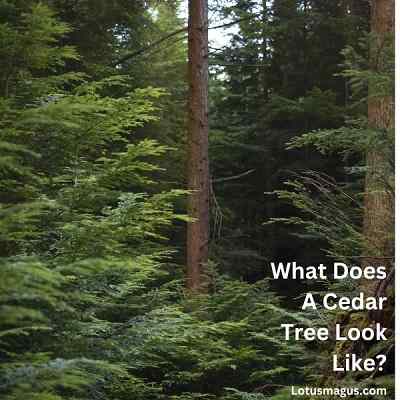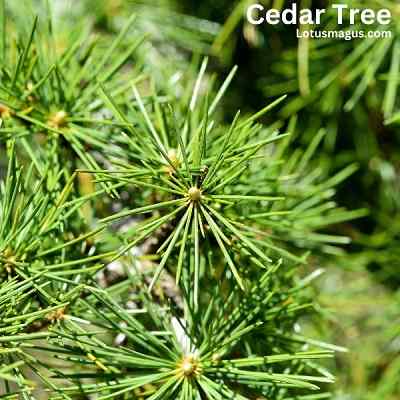Cedar trees, Pinaceae evergreens, are stunning. These trees filter the air, shelter animals, and provide scented wood. If you’re unfamiliar with cedar trees, it might be hard to recognize them. In this blog post, we will discuss in detail what a cedar tree looks like and how to identify it.
What Does A Cedar Tree Look Like?
Cedars look like pines but are different. They have distinctive needles, cones, and bark, making them simple to recognize. They Pines contain bundles of needles, whereas cedars have bluish-green needles on woody branches. Cedar cones are papery like fir cones, unlike pine cones.
Blue-green needle clusters indicate cedar trees. 8-60 mm long open spiral needles. Instead of finger-like scale-like leaves, true cedars have evergreen needles. Cedar tree types may be identified by bark texture. Young cedars have smooth gray bark, while older ones have dark, wrinkled brown bark.
North America, Europe, and Asia are home to Pinaceae cedar trees. Cedar species include Atlantic white, Lebanon, and western red. Cedars live 350-700 years and reach 60-80 feet tall.
Table of Contents
Cedar trees enjoy full light and well-drained soil and are low-maintenance. They may need frequent monitoring and maintenance because to mites and insects.
Cedar trees are lovely and distinctive due to their needles, cones, and bark. Knowing their traits makes them easier to identify, plus they offer shade and animal habitat.
How can you tell if a tree is a cedar tree?
Height, form, needles, cones, and ecosystems define cedar trees. Tall trees with aromatic woody limbs, pyramidal then spreading. These rosettes of slender needles are evergreen. Young spruce trees are huge and conical. Its stiff, prickly needles are on short stalks.
Cedar identification relies on cones. Waxy blue Atlantic white cedar cones become reddish-brown when mature. Cedar trees like humid, marshy conditions, whereas spruce trees prefer colder, drier ones.
Cedar trees are distinguished by their height, form, needles, cones, and habitats. These traits help distinguish authentic cedars from other trees, making identification simpler.

What is special about a cedar tree?
In its native locations, cedarwood is used for building because to its lightness, softness, and durability. Distilling the wood yields a pleasant oil.
True cedar trees, which are not native to the US, are commonly planted as ornamentals. These conifers keep their leaves year-round, losing older leaves in the center in spring.
Cedars symbolize power, endurance, and immortality in many civilizations. Egyptian pharaohs’ tombs contain cedar sawdust from mummification using cedar resin.
All cedars reproduce with barrel-shaped, upright cones. Cedar trees are monoecious, meaning they produce both male and female cones.
Cedar is also associated with many beliefs and taboos. Inappropriate cedar tree harvesting might curse nearby trees.
What is the difference between cedar and pine trees?
Pines have softer, less pointed needles than cedars. Pine needles bend readily. Yet, pine trees come in various kinds, and their mature sizes vary.
Pine and cedar trees are evergreen conifers of the Pinaceae family, although they are distinct genera. Pines are Pinus, whereas cedars are Cedrus.
Cedar is harder than pine, yet both are softwoods. Outdoor and patio furniture made of cedar is durable, rot-resistant, and pest-resistant. Pine wood is used for furniture and interior design, although it may not be as durable as cedar wood outdoors.
Cedar wood is stronger and more durable than pine wood. Cedar is darker than pine.
Cedar wood is stronger and better for outdoor furniture and buildings than pine wood.
Pine and cedar wood have several major distinctions to consider while picking. Pine is usually cheaper than cedar. Cedar is useful for decking, fence, and siding due to its rot resistance. Cedar also smells good.
Some “pine” trees are really fir, cypress, cedar, or spruce. These species vary in appearance, strength, and durability.
Cedar has a warm, rich appearance due to its reddish hue, white highlights, and unusual grain pattern. Pine ranges from light brown to cream.
Many features may distinguish a cedar tree. The tree may be pyramidal or spreading, with small, needle-shaped needles in rosettes on the branches. Cedar trees’ barrel-shaped cones are also unique. Cedar species affect cone color, size, and form.
Pine or cedar depends on your requirements and tastes. Pine is cheaper for inside uses like furniture and flooring, whereas cedar is preferable for outdoor tasks that need rot resistance.

What does natural cedar look like?
Cedar wood is distinguished by its hue. Most cedars are pinkish-red with purple undertones. Cedar wood loses its crimson tones and becomes silver or gray with age. Yellow cedar is milky white to sulfur yellow with black streaks. The finished wood becomes orange-brown.
Due to its deep red color and decay resistance, red cedar is a popular exterior wood species. Western red cedar bark is grayish and stringy, and older trees shed lengthy strips. Scale-like leaves are grouped in flat, fan-like sprays on the twigs and give a peculiar perfume.
Cedrus atlantica, brevifolia, deodara, and libani are the only real cedars. People grow these non-native US plants for decorative reasons. Due to their resemblance, junipers and arborvitae are frequently mistaken for cedars.
Cedar is used for furniture, decks, siding, and roofing. Its inherent resistance to decay, rot, and insects makes it a popular outdoor option, but its unique color and grain pattern make it a favoured inside alternative. Cedar wood is pricey, but its durability and beauty make it worth it.
How can you tell a cypress from a cedar?
Cedar and cypress are frequently compared because to their comparable look and durability. There are major distinctions between the two.
Cypress is orange-brown, but cedar is redder. Both woods seem similar, but cedar has a softer, prickly feel and a cooling perfume, while cypress has a spicy, fresh, herbaceous, and woody scent.
Classification distinguishes cedar and cypress. True cedars and cypresses are of the Cedrus and Cupressus genera, respectively. Cedar trees keep their needle-like leaves year-round, but cypress trees lose them in the autumn.
Cedar and cypress are great exterior materials due to their durability and workability. Their qualities vary. Cedar is stronger and easier to deal with than thick, fine-grained old-growth cypress. Cypress, though, works well by hand.
Cedar’s natural fungicide prevents it from decaying, while cypress’s oils make it weather-resistant. Cedar’s natural perfume repels moths, while cypress’s grounding and relaxing characteristics make it popular in aromatherapy.
Cedar and cypress are good outdoor and woodworking materials. Both long-lasting and robust woods, they vary in look, fragrance, and qualities.
How can you tell real cedar?
Cedar trees are distinguished by their cones, scent, and evergreen needles. The tree’s cones are a straightforward way. All Cedrus species have erect, barrel-shaped cones. Female cones are larger than male cones and stay on the tree until the seeds are ready.
Cedar trees also smell different. Cedarwoods smell different. It repels moths and insects since it’s fragrant.
Real cedars (Cedrus genus) contain thick clusters of evergreen needles on short, woody spur branches. Unlike larches, the needles don’t fall off in the autumn.
True cedars have reddish wood, cones, needles, and scent. Cedar heartwood is pinkish-red or purple. The crimson wood becomes silver or gray as it matures.
Not all “cedar” trees actually cedars. Thuja and Juniperus trees are sometimes called cedars, although they’re not. Thuja, or arborvitae, trees have scale-like leaves that overlap like roof tiles, whereas juniper trees have pointy needle-like needles.
Cedar trees are distinguished by their cones, scent, and evergreen needles. Real cedars are from the Cedrus genus and have reddish-colored wood, unlike Thuja and Juniperus trees.
Write About Cedar Trees
Pinaceae cedars are evergreen conifers. They are native to many regions, particularly the Mediterranean, where its attractive and durable wood has been utilized for ages. Some cedar species may reach 100 feet.
Cedar trees have clustered needles that resemble leaves. They are aromatic and green. Cedar trees provide durable outdoor furniture and construction supplies.
Cedar trees have always been sacred. Cedar was utilized to create palaces, temples, and ships in ancient times because of its beauty and durability. Cedar trees are popular in landscaping and gardening due to their beauty and adaptability.
Cedar trees are diverse. Western Red Cedar, a famous decorative tree, has a deep, reddish-brown hue and an unique perfume. Eastern Red Cedar is a minor species valued for its strong wood.
Cedar trees are appreciated and significant evergreen conifers. Its attractive needles and strong wood make them ideal for gardening, architecture, and furniture. Cedar trees provide great outdoor wood or towering, magnificent trees.
References:
- “Cedar Trees: Types, Identification, and Benefits” by Brandon Lobo, Gardenerdy, https://gardenerdy.com/cedar-trees-types-identification-and-benefits/
- “Cedar Trees: Characteristics, History and Uses” by The Old Farmer’s Almanac, https://www.almanac.com/plant/cedar-trees
- “Cedrus” by Wikipedia, https://en.wikipedia.org/wiki/Cedrus
- “Cedar Tree Identification Guide: Types of Cedar Trees, Uses, and Care” by Matt Suwak, Gardener’s Path, https://gardenerspath.com/plants/trees/cedar-tree-identification-guide/
- “Cedar Trees: Facts, Types, and Uses” by Vanessa Richins Myers, The Spruce, https://www.thespruce.com/cedar-trees-facts-types-and-uses-3269685
Final thoughts
I hope you get the answer on “What Does A Cedar Tree Look Like?”. As you know Cedar trees can enhance any scene. They are simple to maintain and help animals and the environment. Knowing a cedar tree’s appearance and traits makes it easy to spot these lovely trees. To enjoy a cedar tree’s beauty and advantages for years, give it the ideal habitat and water it enough.
Weeping Willow Tree Pros and Cons : 10 Points Explained
© 2024 Lotusmagus.com. All rights reserved. This content is protected by copyright. Visit Lotusmagus.com for more information.
